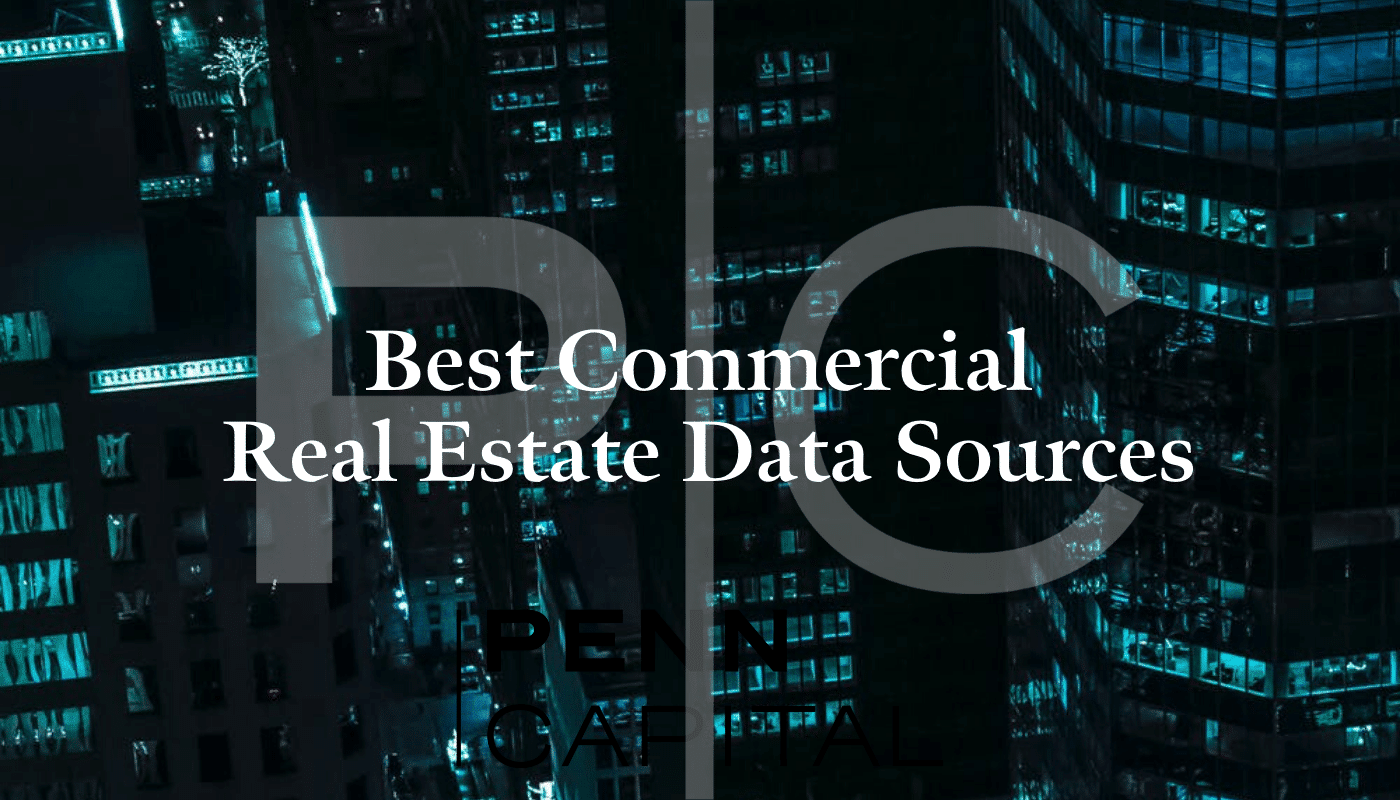Best Commercial Real Estate Data Sources
By Percy Nikora, Owner, Co-Founder

What is Commercial Real Estate Data?
Commercial real estate data is an increasingly powerful tool utilized by almost all of those in the industry – investors, brokers, lenders, developers, and more. CRE data comes in many different forms and can be utilized in different ways, depending on the need. For example, an investor might be interested in demographic or transaction data, whereas a lender might be interested in rent rolls and occupancy data. Meanwhile, a contractor such as a solar installation company might only care about properties that are over 50,000 square feet in size with specific roof orientations.
These are just a few examples of how CRE data is leveraged; in fact, there are many more examples that run the gamut.
Related: Appraisal Valuation Methods You Should Know For Commercial Real Estate
Commercial Real Estate Data: Demographic
Commercial real estate data can take many forms. The most basic data is property-level data. This information is unique to each property and includes the asset type, its location, building size, lot size, square footage, and more.
Then there’s another bucket of data known as transaction data. Transaction data is crucial for investors, brokers, appraisers, banks, and others interested in the investment side of a deal. Transaction data includes the property’s ownership and sales history, loan data, rent rolls, and more, which is used for underwriting the deal.
The third bucket of commercial real estate data is “demographic” data, more commonly referred to as market data. Market data includes economic factors, socioeconomic factors, local supply and demand, market rents, capital market access, local permitting, and more.
For example, demographic data will usually provide insight as to median household income, median household age, purchasing power, rates of ownership vs. renters, in/out-migration to an area, and new household formation.
This data is aggregated to provide investors and other CRE players, an overview of the market environment. Whether an area will be worth investing in or not, and under what circumstances, demographic data, in particular, is useful for those who are interested in determining which building types to invest in.
Sign up to receive our educational newsletter and to gain exclusive access to our next investment opportunity.
CoStar
CoStar is one of the leading sources of online commercial real estate data, particularly as it pertains to the aggregation of demographic data. CoStar utilizes data provided by ESRI and others to offer real-time demographic, business and employment data, and consumer spending information. This data can be presented with both current-year estimates and five-year projections.
In practice, most CoStar users will search for properties based on specific demographic criteria and then compare it to other properties based on their surrounding demographic characteristics. CoStar subscribers can generate up to 7 different demographic reports and 14 individual demographic charts for each property.
Learn more about investing in commercial real estate with Penn Capital
IdealSpot
IdealSpot aggregates public and private sector data to help users model and visualize the ideal location for their next CRE investment. IdealSpot has more than 1,500 datasets in its demographic inventory, including income, education, crime index, household income and value, mortgage risk, occupation, language, and GDP.
Spatial reports can be generated for as little as $99 each. Those looking for more nuanced data might be interested in a consumer demand report. IdealSpot’s consumer demand data provides insight regarding how much demand there is for a specific product (or in real estate, product type). The website offers a competitive mapping tool to show users where their competitors are located, and competitors can be filtered based on predefined specifications. IdealSpot is most valuable for CRE investors in the retail space.
PiinPoint
PiinPoint is unlike the other platforms featured here today in that it is designed primarily with business owners in mind. PiinPoint is a location analytics company that helps business owners discover, compare, and validate locations for expansion. The company does so by providing robust demographic, real estate, market suitability, and mobile data.
Real estate investors, sponsors, and other industry professionals can leverage PiinPoint data for their own purposes, as well. For example, a real estate sponsor might use PiinPoint’s demographic analysis to ascertain the ideal size and type—and, therefore, the potential design and fit-out—of the retail space going into the ground floor of mixed-use development.
Commercial Real Estate Data: Broker Databases
Another valuable source of information is CRE broker databases. The best way to think of broker databases are like modern-day Rolodexes: they are loaded with the contact information of other CRE professionals who may be worth connecting depending on your specific line of business.
For example, a sponsor interested in jumpstarting a project outside of Houston may want to connect with the area’s top debt brokers to discuss strategies for lining up both the debt and equity needed to get the project off the ground. Similarly, a CRE investor can utilize broker databases to find potential investment opportunities. These are a few ways that broker databases can be leveraged. Other service providers and vendors can use broker databases.
Many broker databases also provide valuable insights and resources to their audience via blogs and other publications.
theBrokerList
theBrokerList is a free online portal that aggregates contact information for CRE brokers, investors, contractors, and other vendors interested in making new relationships and getting deals done. Anyone in the CRE industry is eligible to be featured or included in theBrokerList, including managing brokers, leasing brokers (product and tenant reps), investment sales brokers, property managers, appraisers, CRE attorneys, accountants, and project managers.
The platform is agnostic to property type and includes those with specialties in every niche, from retail to hospitality, office to industrial, multifamily, and more. theBrokerList allows its members to message one another, create or join groups amongst themselves, and list their “haves” and “wants” to draw interest from other members who may be able to fill those needs.
RealConnex
RealConnex is similar to theBrokerList but is open to a broader array of professionals. Its members are not confined to the commercial real estate industry. In addition to that, the RealConnex platform was designed to foster cross-industry networking, although the majority of members have at least some loose ties to the real estate industry.
Each member is asked to create a customized profile that specifies their interests, privacy, and networking preferences. “The Business Zone” is a featured area on the platform where members can post, search, raise capital, invest or lend, showcase services, buy, sell, lease, or simply network with each other. All of the user’s activity is monitored in a central dashboard, making information easy to find and track (think: LinkedIn-style newsfeed but with more robust tracking tools).
For industry professionals, RealConnex is a great way to network and prospect for a fraction of the cost of conducting business development in person and in real-time.
Commercial Real Estate Data: Lease and Sales Transactions
Nearly all commercial real estate professionals have some use for lease and sale transaction data. An investor will use this data for identifying market opportunities. An appraiser will use this data when evaluating comps. A lender will use this data to assess the caliber of tenants at a property. A broker will use this data when marketing a property. Contactors will use this data when scouring the market for new business opportunities.
Let’s use commercial tenant data (lease data) as an example. Any leasing broker worth their weight will need to have their finger on the pulse of tenants that are coming and going into any given building in any given market. A broker can use lease data to ascertain when a tenant’s lease is expiring. If it’s expiring within the next two years, the broker will want to contact that tenant to discuss their options for renewing/restructuring their lease or finding a new location. Similarly, that leasing broker may wish to contact the building owner to pitch their services to find new prospects, should it appear that a vacancy is likely to be on the horizon.
Identifying commercial lease and transaction data can be complicated, the former more so than the latter. The following platforms are valuable tools for those interested in locating this type of commercial real estate data.
Compstak
Compstak is a platform that crowdsources commercial lease and sales transaction data from its users. Users include brokers, appraisers, and those doing market research. Lease and sale transaction data are available for free in exchange for those users posting verified information about comps they’ve been involved with.
Compstak requires information (either about the user or the transaction) to be verified to prove its legitimacy. The low-cost structure of Compstak serves as motivation for others to share real-time transaction data in exchange for accessing data that will be equally useful to them. Using this model, Compstak has aggregated lease comps covering more than 10 billion square feet of commercial real estate.
This information has then been collected into “Compstak Analytics,” a premium tool that allows customers to test any investment hypothesis as they proceed with the critical investment, lending, asset management, and leasing decisions.
CoreLogic
CoreLogic is particularly valuable for those interested in more robust commercial property lease and sales transaction data. CoreLogic provides detail about both securitized and non-securitized properties across the country. This data includes critically important mortgage (including mortgage origination and maturity data), which has historically been convenient for the average person to track down. Other data includes detailed property characteristics, sales records, valuation, and digital copies of current county assessor documents.
CoreLogic is best utilized by those interested in obtaining residential property data, as their services for the commercial market remain limited. CoreLogic also has a “Technology and Processing Solutions” (TPS) business line that provides mortgage-related data services for traditional banks and lenders such as credit verification services and compliance and management services. The TPS business line is how CoreLogic can access such robust mortgage data.
Penn Capital can help you invest strategically with the right commercial real estate data source
Reonomy
Reonomy is one of the nation’s largest databases for specific commercial real estate property data. Reonomy aggregates data from a range of public and private data sources, which provides subscribers with just the click of a button. Data includes property, loan, ownership, tenant, and transactional data. Industry professionals use this information to understand various property types in any market across the U.S.
There are over 50 million commercial properties listed on the Reonomy platform. One of Reonomy’s most valuable tools is the data that it possessed. Accurate ownership data, including the phone numbers and email addresses of the owner(s), is notoriously difficult to track down. This is because most commercial property is held in a limited liability company (LLC), not the individual owners’ names.
Reonomy provides robust, accurate ownership data that allows users to bring their due diligence efforts to another level after tracking down baseline lease and sales data. It also offers similar detail about commercial tenants occupying leased properties.
Real Capital Analytics

Real Capital Analytics is perhaps the predominant provider of commercial real estate sales and transaction data in the U.S., having recorded over $18 trillion of commercial property transactions. It’s no wonder that more than 200,000 investors and lenders use the RCA platform.
It is an excellent resource for commercial real estate professionals interested in tracking market trends and changing market conditions as data is uploaded to the site in real-time. RCA can be used to identify the most active originators, lenders, and brokers by geography and property type. This helps industry professionals spot new players entering the market, including potential competition for their existing deals. RCA also publishes a “Capital Trends” report and other industry news.
Conclusion
Commercial real estate data is the linchpin to building a successful real estate portfolio, business network, portfolio, and much more. For beginners, it can be tough to locate CRE data. There are many platforms to utilize, some more useful than others. Navigating through this web of material can be challenging. Knowing where to start is an essential first step.
Equally important is finding commercial real estate data that is accurate and reliable. It is tempting to sign up for multiple platforms and subscribe to different data sources, but be sure those you invest in are worthwhile. Look for data that is provided by verified sources and updated in real-time. Markets can change quickly; having access to accurate real estate data is critically important.
Interested in learning more? Contact Penn Capital for more information.
RELATED ARTICLES
5 Keys to Investing in Distressed Real Estate
5 Keys to Investing in Distressed Real Estate By Ed Rogan, Owner, Co-Founder Buying distressed real estate certainly isn’t for the faint of heart. An inexperienced investor can easily be swayed by the promise of a project sponsor who doesn’t actually have a plan for turning the property around. But that doesn’t mean you shouldn’t…
READ MORE >Gaining an Edge through Cold Calling
Gaining an Edge through Cold Calling By Ed Rogan, Owner, Co-Founder In many ways, commercial real estate is an “eat what you can kill” industry. The most successful investors, developers, brokers and other CRE professionals earn their living by scouring the market to uncover the next big deal. Ask the industry’s best and they’ll often…
READ MORE >Trial by Fire: How We Got Started
Trial by Fire: How We Got Started By Ed Rogan, Owner, Co-Founder People often use the term “trial by fire” to explain how they learned something. In our case, the term is all too appropriate. Looking back on it, the story of how Percy and I got started almost seems unbelievable. We were just…
READ MORE >


